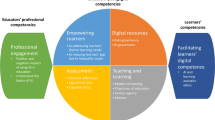Abstract
The Preparing Tomorrow’s Teachers to Use Technology (PT3) initiative has funded various efforts to improve and enhance the technology preparation of preservice teachers. At Arizona State University, these efforts have focused on providing preservice teachers with opportunities to develop, implement, and evaluate their own instructional activities that utilize technology effectively and appropriately in authentic situations, to give them the myriad of tools necessary to integrate technology into teaching and learning activities. This paper focuses on the integration of these efforts into the field-based elementary education program, and discusses our formative evaluation of the field-based technology integration model, through the following questions: What are the preliminary successes of the model with regard to student perceptions, attitudes, and integration of technology into instructional activities? and What components of the model require additions or modifications?
Similar content being viewed by others
References
Abdal-Haqq, I. (1995). Infusing technology into preservice teacher education.ERIC digest. ERIC Document Reproduction Service # ED 389 699
Barab, S., MaKinster, J., Moore, J., & Cunningham, D. (2001). Designing and building an on-line community: The struggle to support sociability in the Internet Learning Forum.Educational Technology Research and Development, 49(4), 71–96.
Beyerbach, B., Walsh, C., & Vannatta, R. (2001). From teaching technology to using technology to enhance student learning: Preservice teachers’ changing perceptions of technology infusion.Journal of Technology and Teacher Education, 9(1), 105–127.
Brush, T. (1997). The effects of student achievement and attitudes when using integrated learning systems with cooperative pairs.Educational Technology Research and Development, 45(1), 51–64.
Brush, T., Igoe, A., Brinkerhoff, J., Glazewski, K., Ku, H. & Smith, T. C. (2001). Lessons from the field: Integrating technology into preservice teacher education.Journal of Computing in Teacher Education, 17(4), 16–20.
Carlson, R., & Gooden, J. (1999). Are teacher preparation programs modeling technology use for pre-service teachers?Journal of School Research and Information, 17(3), 11–15.
Cuban, L., Kirkpatrick, H., & Peck, C. (2001). High access and low use of technologies in high school classrooms: Explaining an apparent paradox.American Educational Research Journal, 38(4), 813–834.
Duhaney, D. (2001). Teacher education: Preparing teachers to integrate technology.International Journal of Instructional Media, 28(1), 23–30.
Ely, D. (1999). Conditions that facilitate the implementation of educational technology innovations.Educational Technology, 39(6), 23–27.
Faison, C. (1996). Modeling, instructional technology use in teacher preparation: Why we can’t wait.Educational Technology, 36(5), 57–59.
Guba, E. & Lincoln, Y. (1981).Effective evaluation. San Francisco: Jossey-Bass.
Hoelscher, K. (1997). The road ahead: Pre-service educators’ ideas for using technology in K-6 classrooms.Computers in the Schools, 13(1–2), 69–75.
Kovalchick, A. (1997). Technology portfolios as instructional strategy: Designing a reflexive approach to preservice technology training.Tech Trends, 42(9), 31–36.
Larsen, A.E., & Clift, R.T. (1996). Technology education in teacher preparation: Perspectives from a year-long elementary teacher education program.Educational Foundtions, 10(4), 33–50.
Lou, Y., Abrami, P., & d’Apollonia, S. (2001). Small group and individual learning with technology: A meta-analysis,Review of Educational Research, 71(3), 449–521.
Mathison, S. (1988). Why triangulate?Educational Researcher, 17, 13–17.
Morey, A., Bezuk, N., & Chiero, R. (1997). Preservice teacher preparation in the United States.Peabody Journal of Education, 72(1), 4–24.
National Council for Accreditation of Teacher Education, Task Force on Technology and Teacher Education, (1997). Technology and the new professional teacher: Preparing for the 21st century classroom. Washington D.C.: Author. (Also available online athttp://www.ncate.org/projects/tech/TECH.HTM.
Nicaise, M. & Barnes, D. (1996). The union of technology, constructivism, and teacher education.Journal of Teacher Education, 47(3), 205–212.
Northrup, P.T. & Little, W. (1996). Establishing instructional technology benchmarks for teacher preparation programs.Journal of Teacher Education, 47(3), 213–22.
Office of Technology Assessment (1995). Teachers and technology: Making the connection. Availale:ftp://gandalf.isu.edu/pub/ota/teachers.tech Washington, DC: U.S. Government Printing Office.
Rodriguez, S. (1996). Preparing preservice teachers to use technology: Issues and strategies.Tech Trends, 41(4), 18–22.
Savenye, W., Brush, T., Middleton, J., Blocher, M., and others. (2002, April),Improving teaching with technology: The “best practices” digital video project. Paper presented at the annual meeting of the American Educational Research Association, New Orleans, LA.
Schrum, L. (1999). Technology professional development for teachers.Educational Technology Research and Development, 47(4), 83–90.
Strudler, N. & Wetzel, K. (1999). Lessons from exemplary colleges of education: Factors affecting technology integration in preservice programs.Educational Technology Research and Development, 47(4), 63–81.
Topp, N.W., Mortensen, R., & Grandgenett N. (1995). Building a technology-using facility to facilitate technology-using teachers.Journal of Computing in Teacher Education, 11(3), 11–14.
Willis, J.W. & Mehlinger, H.D. (1996). Information technology and teacher education. In J. Sikula, T.J. Buttery, & E. Guyton, (Eds.),Handbook of research on, teacher education (2nd ed., pp. 978–1029). New York: Simon & Schuster Macmillan.
Willis, J., Thompson, A. & Sadera, W.(1999). Research on technology and teacher education: Current status and future directions.Educational Technology Research and Development, 47(4), 29–45.
Windschitl, M., & Sahl, K. (2002). Tracing teachers’ use of technology in a laptop computer school: The interplay of teacher beliefs, social dynamics, and institutional culture.American Educational Research Journal, 39(1), 165–205.
Author information
Authors and Affiliations
Rights and permissions
About this article
Cite this article
Brush, T., Glazewski, K., Rutowski, K. et al. Integrating technology in a field-based teacher training program: The PT3@ASU project. ETR&D 51, 57–72 (2003). https://doi.org/10.1007/BF02504518
Issue Date:
DOI: https://doi.org/10.1007/BF02504518




